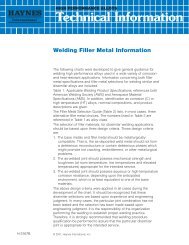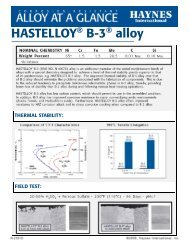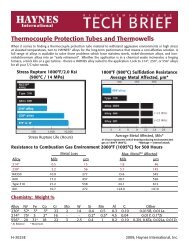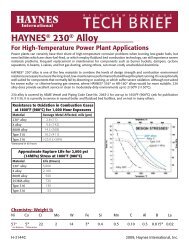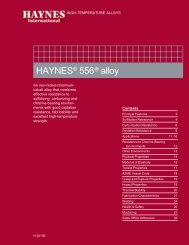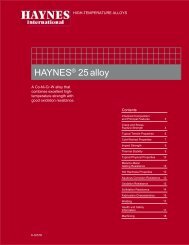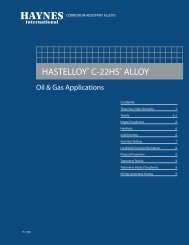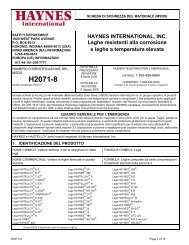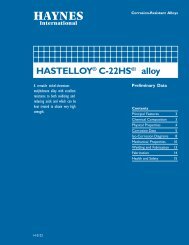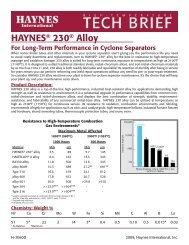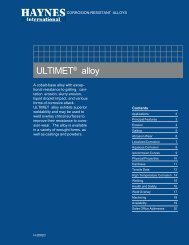Create successful ePaper yourself
Turn your PDF publications into a flip-book with our unique Google optimized e-Paper software.
12. ECOLOGICAL INFORMATIONIn solid form this material poses no special environmental problems. Metal powders, fumes, or dusts may havesignificant impact on air and water quality. Airborne emissions, spills, and releases to the environment (discharge tostreams, sewer systems, ground water, surface soil, etc.) should be controlled immediately.Ecotoxicity: Few plants accumulate cobalt at greater than 100 ppm, the level at which severe phytotoxicity would occur.There is little tendency for chromium III bioaccumulation along the food chain.Environmental Degradation: In water, cobalt is adsorbed greatly to hydrolysate or oxidate sediments. It may be takeninto solution in small amounts through bacteriological activity. In water, chromium III oxide is expected to eventuallyprecipitate to sediments. In air, chromium III oxide is primarily removed by fallout and precipitation. Soils with a highchromium content (
15. REGULATORY INFORMATION (continued)U.S. FEDERALREGULATIONSChemicals subject to the reporting requirements of Section 313 or Title IIIof SARA and 40 CFR Part 372: Aluminum (as a fume or dust), cobalt,chromium, copper, manganese, nickel (as a powder or dust).California=s ASafe Drinking Water and Toxic Enforcement Act of 1986"(Proposition 65)STATE REGULATIONSDuring welding, these products may produce cobalt oxide, nickel compounds,and hexavalent chromium compounds which are known to the State ofCalifornia to cause cancer. State of California, Health and Welfare Agency,1600 Ninth Street, Room 450, Sacramento, CA 95914, Telephone (961) 455-6955.16. OTHER INFORMATIONPennsylvania Worker and Community Right to Know: Aluminum, Cobalt,Copper, Chromium, Manganese, Nickel, and Vanadium (fume or dust) aredesignated environmental hazards on the Hazardous Substance List. Title 34,Part XIII, Chapter 323.MSDS STATUSThis MSDS replaces the 4/11/05 revision for welding consumables. Table 1 and Table 2 were revised withthe addition of <strong>Haynes</strong> 282 TM alloy.Read and understand the manufacturer=s instructions and precautionary labels on the products. SeeAmerican National Standard Institute standard Z49.1 ASAFETY IN WELDING AND CUTTING@ published bythe American Welding Society, PO Box 351040, Miami, FL 33135, and the OSHA publication 2206 (29 CFR1910) available from the U.S. Government Printing Office, Washington DC 20402.The above information has been prepared by Shaw Environmental, <strong>Inc</strong>., under contract with <strong>Haynes</strong><strong>International</strong> and is a compilation of information from various sources believed to be accurate. As theconditions or methods of use are beyond our control, we do not assume any responsibility and expresslydisclaim any liability for any material described herein. Information contained herein is believed to be trueand accurate, but all statements or suggestions are made without warranty, expressed or implied, regardingaccuracy of the information, the hazards connected with the use of the material or the results to be obtainedfrom the use thereof. Compliance with all applicable Federal, State, and local laws and regulations remainthe responsibility of the user.Portions of this document were authored by Teledyne McKay Co. and are used with permission.H-1072-6 Page 6 of 17
Table 1 Bare Wire Welding ProductsMSDS Welding ProductOctober 2005AWS/UNS Normal Composition, Weight PercentALLOY Alloy No. Ni> Co> Cr> Mo W Fe Si Mn> Al> Ti Cu> B Others (V>)HASTELLOY® B alloy N10001 67 2.5*
Table 2 Product Hazard Rating - Hazardous Materials Identification System (HMIS)H = Health Rating F = Flammability Rating R = Reactivity RatingALLOY Alloy No. H F R ALLOY Alloy No. H F RHASTELLOY® B alloy N10001 2* 0 0 HAYNES R-41 alloy N07041 3* 4 3HASTELLOY B-2 alloy N10665 2* 0 0 HAYNES 214J alloy N07214 3* 0 0HASTELLOY B-3 ® alloy N10675 3* 0 1 HAYNES 230-WJ alloy N06231 3* 0 1HASTELLOY C-4 alloy N06455 3* 0 0 HAYNES 242J alloy N10242 3* 0 0HASTELLOY C-22® alloy N06022 3* 0 0 HAYNES 263 alloy N07263 3* 0 1HASTELLOY C-22HSJ alloy 2321** 3* 0 0 HAYNES 625 alloy N06625 3* 0 0HASTELLOY C-276 alloy N10276 3* 0 0 HAYNES 718 alloy N07718 3* 0 0HASTELLOY C-2000® alloy N06200 3* 0 0 HAYNES X-750 alloy N07750 3* 0 0llHASTELLOY G-3 alloy N06985 3* 0 1 HAYNES 556J alloy R30556 3* 2 2HASTELLOY G-30® alloy N06030 3* 4 3 MULTIMET7 alloy R30155 3* 2 2HASTELLOY N alloy N10003 3* 0 0 HAYNES 25 alloy R30605 2* 4 3HASTELLOY S alloy N06635 3* 0 0 HAYNES 188 alloy R30188 3* 4 3HASTELLOY W alloy N10004 3* 0 0 ULTIMET7 alloy R31233 3* 4 3HASTELLOY X alloy N06002 3* 0 0 HAYNES 617 alloy N06617 3* 2 2HASTELLOY D-205J alloy 2916** 3* 0 0 HAYNES GTD222 alloy 2220** 3* 4 3HAYNES® WASPALOY alloy N07001 3* 4 3 HASTELLOY 7 G-35 7 2334** 3* 0 0HAYNES HR-160® alloy N12160 3* 4 3 HAYNES 625 (Low Iron) 2653** 3* 0 0HAYNES 282 TM alloy 2082** 3* 4 3MSDS Welding ProductOctober 2005Note: Ratings applicable for the metal oxide components of each product. Metal oxides are typically found in welding fume.* = Chronic health effects, see Table 5.XX** - <strong>Haynes</strong> metal No. HASTELLOY, HAYNES, and MULTIMET are trademarks of <strong>Haynes</strong> <strong>International</strong>, <strong>Inc</strong>. WASPALOY is a trademark ofUnited Technologies Corp.H-1072-6 Page 9 of 17
MSDS Welding ProductOctober 2005Table 3Shielded Metal Arc Welding (SMAW) Electrode ProductsAlloyAWS/UNSAlloy No.Core Wire composition (1)(~80% by Wt.)Other Coating Ingredients (2)(~20% by Wt.)HASTELLOY B-2 alloy W80665 N10665HASTELLOY B-3 alloy - N10675HASTELLOY C-4 alloy W86455 N06445HASTELLOY C-22 alloy W86022 N06022 Oxides and/orHASTELLOY C-276 alloy W80276 N10276 Fluorides ofHASTELLOY C-2000 alloy - N06200 Aluminum (Al)HASTELLOY G-3 alloy W86985 N06985 Barium (Ba)HASTELLOY G-30 alloy W86030 N06030 Calcium (Ca)HASTELLOY H-9M alloy - N06920 Magnesium (Mg)HASTELLOY W alloy W80004 N10004 Potassium (K)HASTELLOY X alloy W86002 N06002 Sodium (Na)HAYNES 230-W alloy - N06231 Strontium (Sr)HAYNES 25 alloy - R30605 and Titanium (Ti)MULTIMET alloy - R30155ULTIMET alloy - R31233Hastelloy G-35 - N06035(1)(2)Corresponding core wire composition of grade is provided in Table 1 as identified by UNS Number or alloymetal number.Chemical Abstracts Service (CAS) numbers, PEL and TLV-TWA information are provided in Table 4.H-1072-6 Page 10 of 17
Table 4 Exposure Limits for Potentially Hazardous Constituents in Welding FumesMSDS Welding ProductOctober 2005Exposure Limits 8-hour TWA (as mg/m 3 )Metal or Chemical, Symbol CAS Number OSHA Permissible Exposure Limit (PEL) (1) ACGIH TLV (1)Aluminum (Al/Al2O3) 7429-90-5/1344-28-1Argon (4) (A)Carbon Dioxide (4) (CO 2 )Heliun (4) (He)Nitrogen (4) (N)7440-37-1124-38-97440-59-77727-37-9Total Metal Dust as Al: 15, Respirable MetalDust as Al: 5Welding Fume as Al: 5Regarded as simple asphyxiants. Inert gases which may replace air and deprive the body of oxygen.Barium compounds (Ba X) 7440-39-3 Soluble compounds as Ba: 0.5 Soluble compounds as Ba: 0.5Boron Oxide (B 2 O 3 ) 1303-86-2 15 10Boron (B) 7440-42-8 Oxide Dust Total: 15 Oxide Dust Total: 10Calcium (Ca) 7440-70-2 None NoneCalcium Oxide (CaO) 1305-78-8 5 2Carbon Monoxide (4) (CO) 630-08-0 55 (50 ppm) 29 (25 ppm)Chromates (6) 0.1 ceiling (2) (as CrO 3 )Chromium VI Soluble Compounds (6) 0.1 ceiling (2) (as CrO 3 ) 0.05 (as Cr)Chromium VI Insoluble Compounds (6) 0.1 ceiling (2) (as CrO 3 ) 0.01( as Cr)Chromium oxide Cr III (Cr 2 O 3 ) 1308-38-9 0.5 (as Cr) 0.5 (as Cr)Chromium oxide Cr II (CrO) 12018-00-7 0.5 (as Cr -Chromium metal (Cr) 7740-47-3 1 (as Cr) 0.5 (as Cr)Cobalt (Co) and inorganic compounds 7440-48-4 0.1 metal dust and fume (as Co) 0.02 (as Co)Columbium (Niobium)(Cb/Cb 2 O 8 , Nb/Nb 2 O 8 )7440-03-1/1313-96-8NoneNoneCopper oxide fume (CuO) 1317-38-0 0.1 (as Cu) 0.2 (as Cu)Copper (Cu) 7440-50-8 1 (as Cu) 1 (as Cu)Fluorides (6) 2.5 (as fluorine) 2.5 (as fluorine)Calcium Fluoride (CaF 2 ) 7789-75-5Sodium Fluoride (NAF) 7681-49-4Potassium Fluoride (KF) 7789-23-3Aluminum Fluoride (AlF 3 ) 7784-18-1Lithium Fluoride (LiF) 7789-24-4H-1072-6 Page 11 of 17
Table 4 Exposure Limits for Potentially Hazardous Constituents in Welding Fumes (continued)Exposure Limits 8-hour TWA (as mg/m 3 )MSDS Welding ProductOctober 2005Metal or Chemical, Symbol CAS Number OSHA Permissible Exposure Limit (PEL) (1) ACGIH TLV (1)Silicon Tetrofluoride (4) (SiF 4 ) 7783-63-1Hydrogen Fluoride (4) (HF) 7664-39-3Iron oxide (dust and fume)(Fe 2 O 3 ) 1309-37-1 10 (as Fe) 5 (as Fe)Lanthanum (La) 7439-91-0 None NoneLithium (Li/Li 2 O) 7439-92- NoneNone2/12057-24-8Magnesium (Mg) 7439-95-4 None NoneMagnesium Oxide (MgO) 1309-48-4 Fume as MgO: 15 Fume as MgO: 10Manganese (Mn, MnO) 7439-96-5 5 (ceiling) (2) (as Mn) 0.2 (as Mn)Molybdenum compounds (Mo X) 7439-98-7 Soluble Compounds as Mo: 5 Soluble Compounds as Mo: 0.5 (3)Insoluble Compounds as Mo: 3 (3)Nickel (Ni, NiX) 7440-02-0 1 (elemental, soluble and insoluble compounds)(as Ni)1.5 (3) elemental, 0.1 (3) soluble, 0.2 (3) insolublecompounds as NiNitric Oxide (4) (NO) 10102-43-2 30 31Nitrogen Dioxide (4) (NO 2 ) 10102-44-2 9 (ceiling) 5.6 (9.4 STEL) (5)Ozone (4) (O 3 ) 10028-15-6 0.2 (0.1 ppm) 0.1 (0.05 ppm), Heavy workload (7)Potassium (K/K 2 O) 7440-09- NoneNone7/12136-47-7Silica fume (amorp) (SiO 2 ) 69012-64-2 None 2 Respirable DustSilicon (Si) 7440-21-3 Total Dust: 15, Respirable Dust: 5 10Sodium (Na/Na 2 O) 7440-23- NoneNone5/1313-59-3Strontium (Sr/SrO) 7440-24- NoneNone6/1314-11-0Tantalum (Ta) 7440-25-7 Metal and Oxide Dust: 5 Metal and Oxide Dust as Ta: 5Titanium Dioxide (TiO 2 ) 13463-67-7 1510Titanium (Ti) 7440-32-6 None NoneTungsten (W) compounds 7440-33-7 None Insoluble compounds as W: 5 (STEL (5) : 10)Soluble compounds as W: 1 (STEL: 3)H-1072-6 Page 12 of 17
Table 4 Exposure Limits for Potentially Hazardous Constituents in Welding Fumes (continued)Exposure Limits 8-hour TWA (as mg/m 3 )MSDS Welding ProductOctober 2005Metal or Chemical, Symbol CAS Number OSHA Permissible Exposure Limit (PEL) (1) ACGIH TLV (1)Vanadium Pentoxide (V 2 O 5 ) 1314-62-1 0.5 ceiling - respirable dust0.1 ceiling - fume0.05 Respirable Dust or FumeYttrium (Y) 7440-65-5 1 Metal and Compounds as Y: 1Zirconium compounds (Zr X) 7440-67-7 Compounds as Zr: 5 Zr Metal and Compounds as Zr: 5 (STEL: 10)(1)(2)(3)(4)(5)(6)(7)All limits are Total Dust unless indicated otherwise.Ceiling limit - shall not be exceeded instantaneously.Inhalable fraction of particulate - refer to the ACGIH-TLV booklet for a definition.Gases generated by arc welding processes.STEL = Short-term exposure limit - A 15-minute TWA exposure limit.Varies with compound.See additional TLV listings for moderate or light workloads.H-1072-6 Page 13 of 17
MSDS Welding ProductsOctober 2005Table 5 Health Hazard TableThe following table shows the compounds and gases which have been discussed previously, and which may be encountered, their names and formulas, their CAS number, and brieflydescribes possible known short term and long term health effects which may result from excessive exposure.Name of Compound,Formula and CAS NumberOn AnyCarcinogens List?If So,Which Ones?Health Effects Resulting From Excessive ExposureAcute (Short Term)Chronic (Long Term)Welding Fumes and Components of Welding FumesWelding Fumes (not otherwiseclassified)CAS No. - noneYesIARCMay include metallic taste, nausea, tightness of chest, fever,dizziness, dryness or irritation of eyes, nose or throatExcessive levels may cause bronchial asthma, lung fibrosis,pneumoconiosis or Asiderosis.@Chromium VI-Cr VISodium ChromateNa 2 CrO 3 (soluble)CAS No. 7775-11-3Potassium ChromateK 2 CrO 3 (soluble)CAS No. 7789-00-6YesIARCNTPOSHAInhalation and Skin Contact: Irritation of mucous membranesInhalation: Perforation of the nasal septum. <strong>Inc</strong>reasedincidence of lung cancer.Skin Contact: Skin ulceration, dermatitis.Chromium Metal-CrCAS No. 7740-47-3Chromium oxide (Cr II) CrOCAS No. 12018-00-7Chromium oxide (Cr III) Cr 2 O 3YesIARCSkin Contact: Allergic reactions (dermatitis) in some people.None known.Nickel-NiCAS No. 7440-02-0Nickel oxide-NiOCAS No. 1313-99-1YesIARCNTPInhalation: Respiratory irritation. Allergic reactions in somepeople. Metallic taste, nausea, tightness in chest, metalfume fever.Skin Contact: Contact dermatitis with permanentsensitization.Inhalation: Chronic pulmonary irritation. Perforation of nasalseptum. <strong>Inc</strong>reased incidence of lung and larynx cancer.Cobalt-CoCAS No. 7440-48-4Cobalt Oxide - CoOCAS no. 1307-96-6NoInhalation: Pulmonary irritant, cough.Eye Contact: Irritation, conjunctivitisSkin: Mild irritation sensitization, allergic dermatitis.Ingestion: Pain, nausea, vomiting, hypotension (low bloodpressure).Chronic exposure to cobalt is more dangerous than isolatedexposures. Possible lung fibrosis and respiratoryhypersensitivity. Heart disease, elevated red blood cellcounts, chest pain and edema.Copper-CuCAS No. 7440-50-8Copper oxide-CuOCAS No. 1317-38-0NoInhalation: Metal fume fever, muscle ache, respiratory irritant.Skin: Irritation,Ingestion: Nausea, vomiting, abdominal pain; large dosesmay cause stomach and intestine ulceration, and kidney andliver damage.Mild dermatitis and degeneration of mucous membranes.Repeated inhalation can cause chrome respiratory disease.H-1072-6 Page 14 of 17
Name of Compound,Formula and CAS NumberManganese-MnCAS No. 7439-96-5Manganese dioxide-as Mn forfume MnO 2CAS No. 1313-13-9On AnyCarcinogens List?If So,Which Ones?NoTable 5 Health Hazard Table (continued)Acute (Short Term)Can include metal fume fever, dry throat, coughing, tightchest, low back pain, vomiting, fatigue, headacheHealth Effects Resulting From Excessive ExposureMSDS Welding ProductOctober 2005Chronic (Long Term)AManganism.@ SENSITIVITY VARIES. Affects centralnervous system. Muscular weakness, tremors, symptomssimilar to Parkinson=s disease. Exposed employees shouldget quarterly medical examinations for manganism.Vanadium Pentoxide (V 2 0 5 ) No Irritant to mucous membranes. Metallic taste, cough, throatand eye irritation, eczema.Nasal catarrh, nose bleeds, chronic respiratory problems.Iron-FeCAS No. 7439-89-6Iron Oxide-Fe0CAS No. 1345-25-1Iron Oxide-Fe 2 0 3CAS No. 1309-37-1Iron Oxide-Fe 3 0 4CAS No. 1309-38-2No Probably none, except as nuisance dust. Possible siderosis if exposures are excessive and long term.Regarded as benign. Lungs clear gradually after exposure isended.Calcium Fluoride CaF 2(Insoluble)CAS No. 7789-75-5Sodium fluoride NaF fume(Soluble)CAS No. 7681-49-4Potassium fluoride KF(Soluble)CAS No. 7789-23-3Aluminum Fluoride AlF 3(Insoluble)CAS No. 7784-18-1Lithium Fluoride LiF(Slightly soluble)CAS No. 7789-24-4NoCaF 2 probably inert. Soluble fluorides may be irritants andcorrosive to mucous membranes.Soluble portions may cause osteoporosis and mottling ofteeth, but effects seem reduced in presence of iron as inwelding electrode fumes.Gases Generated by Arc Welding processesFluorides: i.e., SiliconTetrafluoride SiFCAS No. 7783-61-1Hydrogen fluoride HFCAS No. 7664-39-3See soluble fluorides portion under Welding FumesNitric oxide-NO No Irritant to mucous membranes, drowsiness. Chronic respiratory disease.H-1072-6 Page 15 of 17
Name of Compound,Formula and CAS NumberCAS No. 10102-43-2Nitrogen dioxide-NO 2CAS No. 10102-44-2On AnyCarcinogens List?If So,Which Ones?NoTable 5 Health Hazard Table (continued)Acute (Short Term)Irritant to mucous membranes, coughing, chest pain,pulmonary edema.Health Effects Resulting From Excessive ExposureChronic respiratory disease.MSDS Welding ProductOctober 2005Chronic (Long Term)Ozone-O 3CAS No. 10028-15-6No Irritant to mucous membranes, pulmonary edema. Chronic respiratory disease.Carbon monoxide-COCAS No. 630-08-0NoHeadache, rapid breathing, oxygen deprivation, confusion,dizziness, weakness.Oxygen deprivation.Argon-ACAS No. 7440-37-1Carbon dioxide-CO 2CAS No. 124-38-9Helium-HECAS No. 7440-59-7Nitrogen-NNoInert gases which may replace air and deprive the bodyof oxygen. (CO 2 is not inert but effect is as above).None knownH-1072-6 Page 16 of 17
MSDS Welding ProductsOctober 2005Table 6Welding Fumes and Gases InformationPRODUCTS FUMES EXPECTED GASES EXPECTEDBare Wire Products used in Gas MetalArc Welding (all alloys listed in Table 1)Bare Wire Products used in Gas TungstenArc Welding, plasma arc welding andother similar processes (all alloys listed inTable 1)All Shielded Metal Arc Welding electrodealloys listed in Table 3Bare Wire Products used in SubmergedArc Welding (some alloys listed inTable 1)Complex oxide combinations of all elementspresent in the welding wire grade listed inTable 1The exposure limit for hazardousconstituents in welding fumes is listed inTable 4Same as above, however, fume volume isvery small under normal GTAW conditionsComplex oxide and fluoride combinations ofall electrode ingredients listed in Table 3Same as above, however, fume volume isvery small under normal SAW conditionsNormally low. Ozone and oxides of nitrogengeneration possible at welding arc or well awayfrom arc.Inert shielding gases can cause asphyxiation inconfined welding spaces and unventilated areas.Same as aboveNormally low, if any symptoms indicate the need,check for gaseous fluorides and/or oxides ofnitrogenSee Health Hazard Data given in Table 5 forsymptoms.Same as aboveOther conditions which also influence the composition and quantity of the fume and gases to which employees may be exposed include:(1) coatings on the metal being welded (such as paint, plating, galvanizing)(2) the number of welders and volume of the work space(3) the quality and amount of ventilation(4) position of the welder=s head relative to the fume plume, and(5) presence of contamination in the atmosphere (such as chlorinated hydrocarbon vapors from cleaning and degreasing).H-1072-6 Page 17 of 17




